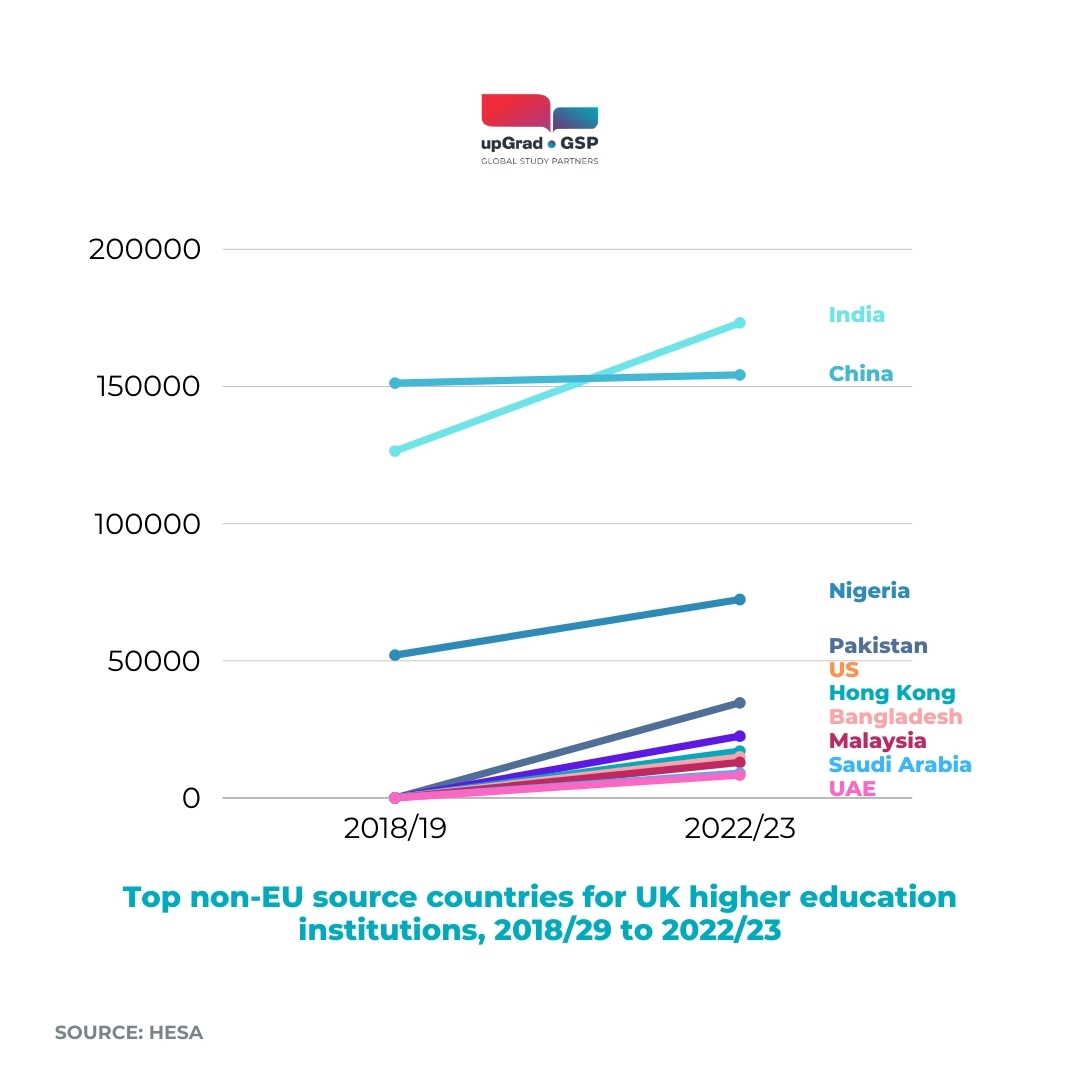UK universities experienced record international enrolments in the 2022–2023 academic year, reaching a new high of 758,855 students and marking a 12% increase from the previous year. The surge was driven primarily by non-EU students, with India surpassing China as the leading source country for the first time since 2018. This growth in the number of international students depicts the UK’s appeal as a premiere study abroad destination.
Growth from non-EU countries
The Higher Education Statistics Agency (HESA) recently released data for 2022–2023, revealing a remarkable increase in the number of non-EU students enrolling in UK universities. Indian students led the charge, with 173,190 students choosing the UK as their study destination—a staggering 37% increase from the previous year. 
This development marks the first time India has overtaken China, which sent 154,260 students, representing just a 2% increase. Nigeria and Pakistan also saw notable growth, with 72,355 (+39%) and 34,690 (+50%) students, respectively. Other notable non-EU markets included: the United States (22,540, -2%), Hong Kong (17,095, +3%), Bangladesh (14,945, +18%), Malaysia (13,005, +7%), Saudi Arabia (9,045, +3%) and the United Arab Emirates (8,350, +3%).
Enrolment in EU students in UK universities
While the growth from non-EU countries was noticeable, enrolments from EU countries saw a decline, reflecting ongoing adjustments in the post-Brexit landscape. France, Ireland, Italy, and Spain remained the top EU source markets, with France leading at 10,305 students and remaining as the largest EU source market.
The decline in EU enrolments is largely attributed to the aftermath of Brexit, which resulted in EU students losing their “home fee” status and becoming less eligible for financial aid. Although EU enrolments have decreased, this has been more than compensated for by the surge from non-EU countries, mainly from India, Nigeria and Pakistan. These three countries alone account for an increase of nearly 79,000 students, which far exceeds the decrease of 24,640 students from the EU.
Impacts of recent policy changes
The release of the 2022–2023 enrolment data coincides with recent changes to UK immigration policies. In January 2024, the government limited the ability of most international students to bring family members to the UK. Additionally, adjustments were made to the salary thresholds for graduates transitioning to skilled visas. These policy changes have prompted discussions regarding their potential influence on future international student enrolments in the UK.
Some industry leaders expressed concerns regarding the timing of the policy reforms, particularly in relation to the availability of recent enrolment data. Such questions include challenges this poses for universities and policymakers in making informed decisions about international student recruitment.
Financial challenges and future outlook
The financial stability of UK universities is also being closely monitored. The University and College Union (UCU) reported that 66 universities are experiencing financial challenges, accounting for over a third of institutions in the UK. This development comes at a time when domestic enrolments have seen a downward trend.
Mark Corbett, head of policy and networks at London Higher, warned that if the current trend of declining visa applications continues, it could result in nearly a billion pounds in lost revenue for UK universities in 2025. The UCU has called for an “emergency rescue package” or financial support to help stabilise institutions facing economic difficulties.
Looking ahead, there is an outlying optimism that the new Labour government, led by Keir Starmer, may take a more welcoming approach to international students. Education Secretary Bridget Phillipson has already stated that international students are “welcome” in the UK, but she also emphasised that Labour will “manage migration carefully.”
Conclusion
The 2022–2023 enrolment data marks a historic milestone for the UK’s international education sector, with a record-breaking number of students coming from non-EU countries. This growth underscores the UK’s continued appeal to students from diverse global markets.
While some challenges remain concerning immigration policies and the financial situation of UK universities, the surge in non-EU enrolments is a positive indicator of the UK’s strong position in the global education landscape.
To learn more news, updates and exciting study opportunities available for international students in the UK, please visit our blog or contact our business development experts for more information.




